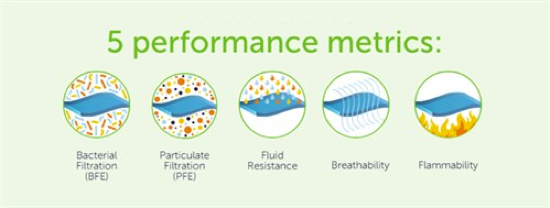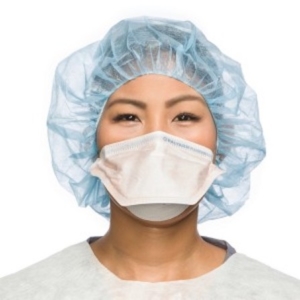So, how will I know how each mask is rated?
Simply look for ASTM Level 1, 2, or 3 on the face mask package. However, not all face masks are ASTM-rated, so it’s important to check before you choose. It’s worth the effort to find face masks that DO carry the ASTM rating, to be sure you’re getting the proper level of protection.
Tell me more about how masks are tested
The five performance metrics and their related tests are:
- Fluid Resistance – Test ASTM F1862
This test evaluates the resistance of a medical face mask to penetration by a small volume (~2 mL) of synthetic blood at a high velocity (80 mmHg, 120 mmHg, or 160 mmHg). The mask either passes or fails based on visual evidence of synthetic blood penetration. - Breathability – Test MIL-M-36954 C: ΔP
This test determines the face mask’s resistance to airflow. A controlled flow of air is driven through the mask, and the pressure before and after is measured. The difference in pressure is divided by the surface (in cm2) of the sample. A lower breathing resistance indicates a better comfort level for the user. - Bacterial Filtration (BFE) – Test ASTM F2101
This test measures the percentage of bacteria larger than 3 microns filtered out by the mask. The challenge material used is Staphylococcus aureus. - Particulate Filtration (PFE) – Test ASTM F2299
This test measures the percentage of particles larger than 1 micron filtered out by the mask. The challenge material used consists of latex aerosol concentrations in a controlled airflow chamber. - Flammability – Test 16 CFR Part 1610: Flame Spread
This test exposes the face mask material to a flame and measures the time required for the flame to proceed up the material a distance of 127 mm (5 inches). Class 1 means the material exhibits normal flammability and is acceptable for use in clothing.

ASTM F2100-11: Standard Specification for Performance of Materials Used in Medical Face Masks
Does an ASTM-rated face mask provide all the protection I need?
It protects your nose and mouth against splashes and sprays of blood and other bodily fluids, as well as bacteria and particulate matter of the sizes indicated in the above table; however, face masks do not provide respiratory protection against airborne diseases. For that purpose, a respirator is required.
| Test | Level 1 Barrier | Level 2 Barrier | Level 3 Barrier |
|---|---|---|---|
| ASTM F1862 (Fluid Resistance) | 80 mmHg | 120 mmHg | 160 mmHg |
| MIL-M-36954 C: P (Breathability) | < 4 mm H2o | < 5 mm H2o | < 5 mm H2o |
| ASTM F2101: BFE (Filtration 3um) | > 95% | > 98% | > 98% |
| ASTM F2299: PFE (Filtration 1um) | > 95% @ 0.1 micron | > 98% @ 0.1 micron | > 98% @ 0.1 micron |
| 16 CFR Part 1610: Flame Spread (Flammability | Class 1 | Class 1 | Class 1 |
What is a respirator?
A respirator is a personal protective device that is worn on your face, covers at least your nose and mouth, requires fit-testing, and is used to reduce your risk of inhaling hazardous airborne particles (including dust particles and infectious agents), gases or vapors.
One of the most commonly used respirators is a NIOSH-approved N95 Respirator mask, which has been tested to filter out at least 95% of airborne particles. A Surgical N95 Respirator is a NIOSH-approved N95 Respirator that has been cleared by the FDA for use as a surgical mask. Unlike other masks, N95 respirators must be fit-tested for each individual to ensure proper protection.
For more information about the Respirators and surgical masks, see OSHA Video: The Difference Between Respirators and Surgical Masks.
Sources
- CG Davies et al, Ann R Coll Surg Engl 2007 89(8): 770–772; S Endo et al, Jour Hospital Infection 2007 (67) 1: 56–61; DC Berridge et al, Br J Surg 1993 80 (11): 1379-80.

